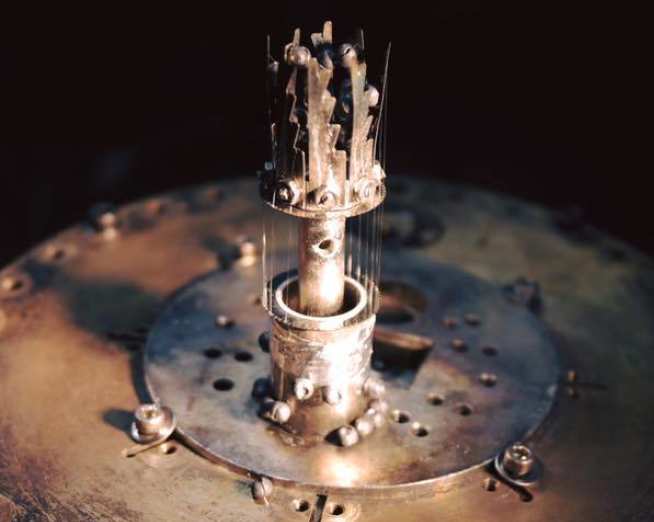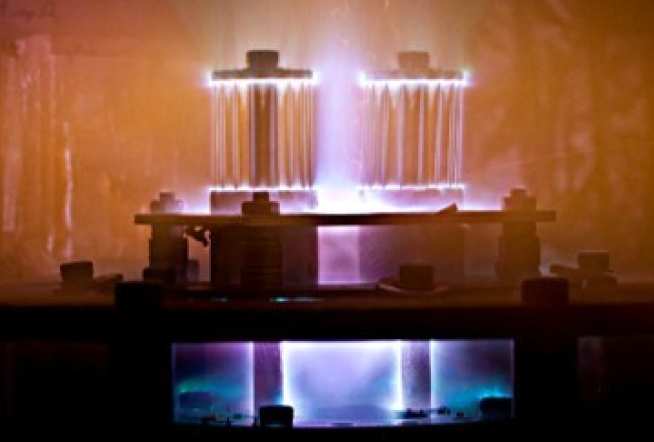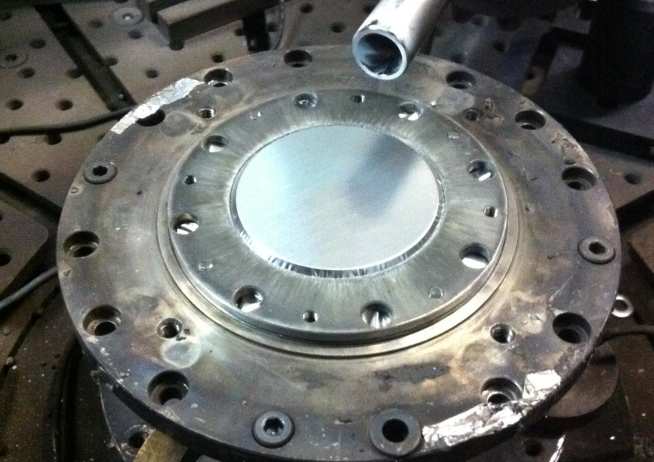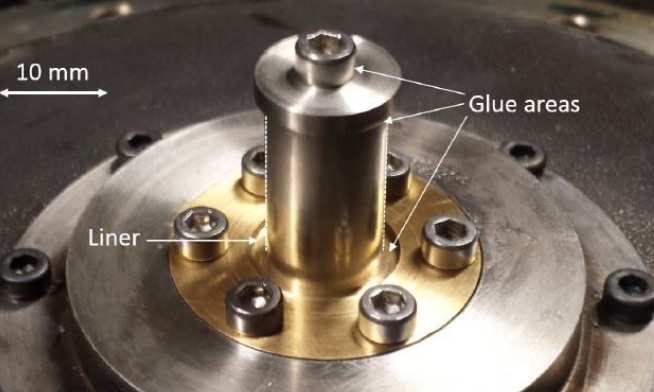Load section
The MAGPIE generator delivers a 1.4 MA peak current, 250 ns rise time pulse to the vacuum chamber through a tapering transmission line. Due to MAGPIE's high impedance (1.25 Ω), it is considered a "stiff" generator, where the impedance of the generator is much higher than the impedance of the load, and hence the load geometry does not significantly affect the magnitude or the rise time of the current pulse. As such, MAGPIE can drive a diverse range of load geometries, and we present some of these below.
Wire array Z-pinches
---Copy--t_1455548653224_x2--tojpeg_1585829557682_x2.jpg)
These consist of a cylindrical cage of thin wires driven in parallel. As the current pulses passes through the wires, they heat due to resistive dissipation. The wires quickly undergo an "electrical explosion", forming a dense column of gas and microscopic liquid droplets. The current heats the outside of this column, forming a coronal plasma. This plasma is electrically charged, and so feels the Lorentz or JxB force radially inwards, formed by the current flowing through the plasma and the global magnetic field surrounding the entire array. This accelerates the plasma inwards, and more plasma is ablated from the gasified wire to replace it, resulting in streams of plasma flowing towards the centre of the array.
At the centre, the plasma streams collide, forming a column known as the "precursor". The precursor to what? Well, as more and more plasma is ablated from the gas columns, the columns are depleted of mass, and eventually a break forms. At this point, the current can no longer pass through the gas columns, and it instead switches to the remaining plasma, accelerating it all inwards and sweeping up any trailing mass in a "snow plough" implosion. When all this matter arrives on axis, it collides with the precursor, forming a very hot and dense plasma column which rapidly radiates away the kinetic and thermal energy as light, mostly in the X-ray spectrum. Wire array Z-pinches are extraordinarily efficient, converting 15% of the stored electrical energy in the capacitor banks into X-rays. These X-rays can be used to drive Hohlraums for Inertial Confinement Fusion, or for launching photo-ionisation fronts through gases for laboratory astrophysics studies.
On MAGPIE, we often use around 16 or 32 wires, around 4-50 μm in diameter, in a 16 mm tall and 16 mm wide array. We use wire materials such as aluminium, copper and tungsten. By choosing the material and array dimensions, we can tune the spectrum and the intensity of the X-ray pulse. Recently, we have been studying cylindrical wire arrays as a driver for turbulent columns of plasma, using carbon wires (actually 2B mechanical pencil refills!) to produce a long-lasting plasma with low radiative cooling.
Exploding Wire Arrays

Similar to the imploding arrays above, the exploding array consists of a cage of thin wires, now surrounding a central conductor, through which the electrical current returns to ground after passing through the wires. This means that instead of being accelerated inwards, the plasma is now accelerated radially outwards. The same physics applies with the electrical explosion, ablation of plasma and eventual wire-breaks and explosion, but no precursor forms because there is no converging flow.
Exploding wire arrays are used in a diverse range of experiments. Initially they were invented to study the ablation dynamics of imploding arrays (and as such are often called "inverse" arrays to contrast them with the imploders), because they offer much better diagnostic access for the streams, unimpeded by the dense wire cores which block the line of sight. In current experiments on MAGPIE, we use them as a long lasting source of supersonic, magnetised plasma, which we can collide with obstacles to form astrophysically-relevant shocks or study fundamental processes such as magnetic reconnection.
Parallel Exploding Wire Arrays

By placing two exploding wire arrays side-by-side and driving them in parallel, we can create a geometry with colliding magnetised plasmas. This is a very open geometry for exploring magnetic reconnection in high-energy-density plasmas, and this fundamental process includes phenomena such as magnetic flux pile-up, instabilities (such as plasmoid formation) and particle acceleration.
By changing the array geometry and wire material we can change the regime of magnetic reconnection, for example studying radiatively cooled reconnection using aluminium wires, or asymmetric reconnection by altering how strongly the two arrays are driven.
Radial Foils

Here we stretch a thin foil horizontally between the anode and cathode. The cathode here is a thin post in the centre, and the anode is a coaxial ring. Hence the current passes radially outwards, rather than vertical, and the medium is uniform, rather than a discrete set of wires. Now plasma is ablated from the top surface, and is swept upwards and towards the axis by the strong azimuthal magnetic fields. The collision of the material on axis, and the collimating by the azimuthal magnetic fields launches a jet upwards.
These jets are reminiscent of the jets observed from Young Stellar Objects, and can be used in a variety of configurations - for studying instabilities in jets, passing through clouds of neutral gas to look at radiative cooling instabilities, or head-on in a collision geometry with another jet or an obstacle.
Cylindrical Liners

MAGPIE can also drive a current through a thin metal cylinder filled with gas. As the current heats the liner, it launches shock waves which are coupled into the gas. These shockwaves heat the gas, whih can lead to photo-ionisation ahead of the shock waves as photons race ahead and heat the gas ahead of the shock.
Shocks can be launched either in a converging configuration or diverging configuration, analogous with the imploding and exploding arrays discussed above. Again, the material of the liner, and the gas composition and pressure have a dramatic effect on the physics observed, allowing us to study these radiative shocks over a large parameter range which is of interest to astrophysical objects.


